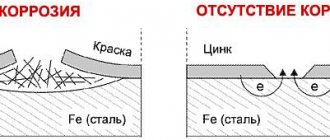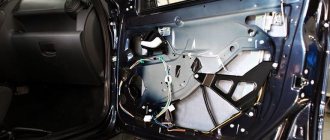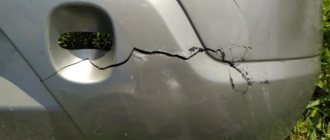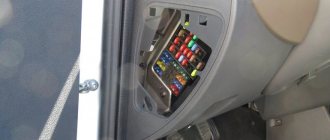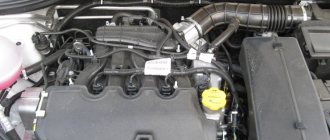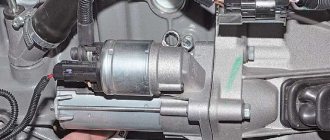The information is intended for use by service station employees. The above data is systematized using official directories of vehicle manufacturers. This information is for reference only and may vary depending on your specific vehicle. If you are unsure, refer to the vehicle manufacturer's additional documentation and information plates. We are not responsible for the use of this information when refilling the air conditioner. All work on refilling the air conditioning system must be carried out by specially trained personnel using certified equipment. Posting this information in other sources is permissible without the consent of the owner of this site, but with a link to it.
Back call
Everything you need to know about auto air conditioner repair Hello.
Finally, through the efforts of the main leader himself, a month-long weekend has arrived and the opportunity has arisen to describe all the specifics of our work. The difficulty... Read more » Diagnostics of a car air conditioner Hello. I am glad that you have visited the most rarely visited page on our website. Unfortunately, the average level of car user... Read more » Replacing a compressor bearing The service life of modern cars is about two hundred thousand kilometers. This axiom has been proven by many automakers. The main method of pumping money out of owners is... Read more » Repairing a car air conditioning tube A modern car requires more than just gasoline or spare parts. He needs constant care and careful care. This truism, first of all,... Read more » Repair of rear air conditioner tubes of a Volkswagen T5 Time and salt do not spare anyone. Another T5 Multivan arrived for air conditioner repair. The problem, as always, came from a well-known place... Read more » Attention. When carrying out any type of work on the car related to depressurization of the air conditioning system, completely unload the refrigerant and then reload the system in the required volume (see below).
UNLOADING (REMOVING) REFRIGERANT
Attention. Work on unloading the refrigerant should be carried out in accordance with the operating instructions for the service equipment.
Unscrew the cap on any of the 2 fittings (you must work with gloves)
Press the valve spool with a suitable thin tool to release the refrigerant from the system.
This work must be done outdoors. When releasing the refrigerant, do not rush, then it will have time to evaporate. Keep in mind that some oil may splash, so stock up on cleaning material.
Before loading the refrigerant, it is necessary to evacuate the air conditioning system in accordance with the operating instructions for the service equipment.
Attention. Work on loading refrigerant should be carried out in accordance with the operating instructions for service equipment.
| Figure 4-1 — Filling the air conditioning system with refrigerant: 1 — high pressure circuit fitting; 2 - low pressure circuit fitting |
Attention. When the engine is not running, refrigerant is charged through the high-pressure circuit, Figure 4-1. If the system is not fully loaded with refrigerant, reload with the engine running and the air conditioning system turned on through the low pressure circuit with gaseous refrigerant.
The mass of the refrigerant charged into the system (R134a, also known as HFC-134a freon) is 475 ± 35 g. Special SP10 oil has been added to the refrigerant to lubricate the compressor. It is strictly prohibited to use other types of refrigerants and oils in the system.
CHECKING FOR REFRIGERANT LEAKS
Attention. Work to detect refrigerant leaks should be carried out in accordance with the operating instructions for the leak detector.
The use of freon in air conditioning systems is due to the fact that during evaporation it absorbs heat and then releases it during condensation. This is the principle on which all air conditioners operate.
Working principle of a car cooler
It is impossible to properly service a car’s air conditioner without knowing its structure and operating principle. The climate control system includes the following elements and units:
- external heat exchanger (condenser), installed next to the radiator of the engine cooling system;
- internal heat exchanger (evaporator), mounted in the cabin air duct;
- the fins of both heat exchangers are forcedly blown by fans;
- the compressor, which creates the necessary freon pressure in the circuit, is driven by a belt drive from the crankshaft;
- expansion valve, gas dryer;
- connecting freon lines made of copper tubes.
Key moment! The operating principle of any air conditioner is based on the ability of the refrigerant to evaporate at sub-zero temperatures. At the moment of evaporation, freon quickly removes a large amount of heat from the air, significantly reducing its temperature.
To properly charge a car air conditioner, you need to imagine the operating cycle of the air conditioning system:
- While in a liquid state, the refrigerant is supplied to the evaporator, through which a fan drives hot air. Freon evaporates, takes away heat from the flow and is sent further - to the compressor.
- Inside the blower, the gas is compressed and moved to an external heat exchanger. The boiling point of a substance under pressure increases, so the freon in the external radiator condenses and releases the accumulated heat to the outside air.
- After flowing through the dryer and expansion valve, the refrigerant pressure drops again. The gas again moves into the internal heat exchanger to evaporate and go through the cycle again.
Answers
TOP products in the store (more)
Lada.Online
Lada (“Lada”) is a brand of cars produced by JSC AVTOVAZ. Previously, it was used only for export cars, and for the domestic market, cars were produced under the Zhiguli brand. In 2004, the management of AVTOVAZ announced the transition to the Latin alphabet for the official spelling of the names of all cars produced by the plant: Lada - instead of "VAZ" and "Lada".
Lada.Online is the largest Russian-language automotive resource with a daily audience of thousands, which is dedicated primarily to cars of this brand, the domestic automotive industry and the automotive world in general.
This site is not the official LADA website.
© 2022 Lada.Online. Copying of material is permitted only with a link to the source.
Source
Signs of freon deficiency
Since the gas pressure in the circuit can reach 20–25 Bar, a natural refrigerant leak of up to 10% is allowed on a used car. If the losses exceed the specified value, the cooling efficiency decreases noticeably - the air conditioner drives warm air.
When faced with a similar problem, arm yourself with the operating instructions for the machine, find the location of the heat exchangers, supply pipes and make sure that secondary signs of gas leakage appear:
- traces or drops of oil at pipeline joints;
- freezing of one or both highways;
- one of the heat exchangers (usually the evaporator) is covered with frost;
- Using a thermometer, measure the air temperature at the outlet of the deflector - it should correspond to the cooler setting.
Reference. Freon contains synthetic or mineral oil to lubricate the compressor. Therefore, at leaky joints, traces of the lubricant component appear first.
Before filling the air conditioner with freon, be sure to identify and repair the leak. Tighten the union nuts with a wrench and check the system for leaks using the only method available in the garage - vacuuming. Read more about this operation below.
What is air conditioner maintenance on Grant?
Maintenance of a car air conditioner on Grant consists of three main components:
- Replacing the cabin filter.
- Cleaning the air conditioner.
- Refilling freon.
It is recommended to change the cabin filter at every service - once every 10-15 thousand kilometers. If the car is used in rural areas, then every 7-8 thousand, since a huge amount of dust from country roads settles on it.
Cleaning the air conditioner is the process of filling the system with special foam. It kills germs and bacteria, cleans the air ducts and evaporator from mold and other contaminants.
The foam is charged through the air ducts and drain tube and is removed along with the dirt by a powerful stream of hot air from the heater. It is recommended to perform cleaning every year or when a corresponding smell appears.
Refilling the refrigerant involves draining the old freon and part of the used oil. This procedure is carried out in order to perform repairs or every 2-3 years of operation.
Refueling equipment
Service station technicians practice several methods of refueling car air conditioners. For a car enthusiast who is new to garage conditions, only one method is available - a complete replacement with filling in a new portion of refrigerant by weight. To work, you need to rent a set of equipment and accessories:
- vacuum pump equipped with a check valve;
- pressure gauge station with two filling hoses, blue and yellow;
- electronic scales in a floor or tabletop version (kitchen scales are suitable, showing weight with an accuracy of 1 gram);
- adapter for the service port (fitting) of a specific car model;
- oil injector - a small container connected to the filling hose.
Note. The cost of renting a set of equipment used for refilling refrigeration machines starts from 1000 rubles. per day. Refrigerant and oil are purchased separately.
To refill the car air conditioning system yourself, you need to find out the amount and brand of freon being filled. As a rule, this data is contained in the machine’s operating instructions, plus there is a nameplate or sticker under the hood. Two characteristics are indicated - the brand and weight of the refrigerant in the system. Accordingly, you need to buy the required amount of gas, taking into account a reserve of 5–10% for purging and unforeseen losses.
The vast majority of modern vehicles use R134a freon, which replaced the more dangerous and harmful R12 gas . During the process of adding refrigerant using an injector, liquid lubricant for the compressor is dissolved. You will need 30 ml of special polyalkylene glycol oil (abbreviation PAG on the package).
Stage two - filling the system with refrigerant
Before refueling, you need to attach the oil injector to the freon cylinder and pour 30 ml of lubricant into it. Then close the previously open manifold and inlet valves, and disconnect the hose from the vacuum pump.
Important point! The car's coolant circuit must be filled with freon, which is in a liquid state. To fill, the tank should be turned upside down so that the outlet pipe is at the bottom. Then the gas phase will not enter the hose.
Further refueling of the air conditioner with your own hands looks like this:
- Attach the yellow hose to the injector bottle and open the reservoir valve.
- After turning off the vacuum pump, the yellow filling tube filled with air. Its removal is carried out by purging: slightly open the right valve of the pressure gauge station for 1–2 seconds. The refrigerant pressure will push the air out.
- Place the cylinder on the electronic scale with the bottom up and reset the display.
- Open the left valve of the gauge manifold and watch the scale readings. The pressure gauge needle should move in the direction of increasing pressure.
- When the display reads the required amount of gas, close the valve of the service port, manifold and cylinder.
- Start the car engine and check the operation of the air conditioner in cooling mode.
- Bleed freon from the hoses using the same purge - open the right valve of the station. Disconnect the cylinder and all connections, close the fitting with a protective cap.
During the charging process, it sometimes happens that the required amount of refrigerant does not want to flow into the air conditioner circuit on its own. The vacuum created in the system is not enough to draw in the liquid phase of freon. The solution is simple: start the engine, turn on the cooler and wait until the compressor starts. At this moment, the flow will resume; the main thing is to close the tap in a timely manner. The filling rate indicated on the plate must not be exceeded.
How to unload and load refrigerant from the Lada Largus air conditioning system
- When performing work related to depressurization of the air conditioning system, it is necessary to completely unload the refrigerant and then reload the system
- Before bleeding the system, you must follow safety rules and wear goggles.
- Discharge the refrigerant from the air conditioning system outdoors or in a well-ventilated area.
- The refrigerant turns into a gaseous state at atmospheric pressure.
- Release the refrigerant from the system in a very thin stream.
- When bleeding the refrigerant, some of the oil mixed with it may splash out.
- To protect the engine compartment from contamination, place a cleaning cloth around the service valve.
- We prepare the car for work, open the hood
- Unscrew the threaded cap of any of the two service valves
- Using a thin screwdriver with a long blade, press the tip of the valve spool and bleed the refrigerant from the system
- Before pumping in refrigerant, you need to evacuate the air conditioning system.
- To completely remove air and water vapor from the system, you need to use a two-stage vacuum pump
- Refrigerant must be pumped in with the engine off via the high pressure circuit.
- The mass of refrigerant charged into the system (R134a) is 475 ± 35 g.
- If the system is not fully loaded with refrigerant, reload with the engine running and the air conditioning system turned on through the low pressure circuit with gaseous refrigerant.
- Checking air conditioning system elements
- Check the elements of the air conditioning system for mechanical damage, replace damaged components.
- Checking the condition of the accessory drive belt
Check the condition of belt 2, auxiliary equipment drive. The presence of cracks, fraying and delamination of the belt is not allowed. If necessary, replace the accessory drive belt:
- — turn the automatic tension roller 3 of the auxiliary equipment drive belt clockwise;
- — block tension roller 3 with a hex key;
- — remove belt 2 of the auxiliary equipment drive;
- — remove tension roller 3 and bypass roller 4;
- — install new tension and idler rollers;
- — turn the automatic tension roller 3;
- — block tension roller 3 with a hex key;
- — install a new auxiliary equipment drive belt 2;
- — unlock tension roller 3.
- The removed accessory drive belt must be replaced.
- When replacing the accessory drive belt, be sure to replace the tension and idler rollers.
- Checking the inclusion of the compressor electromagnetic clutch
- Start the engine and warm it up to operating temperature, turn on the heater fan motor and the air conditioning switch.
If necessary, eliminate the malfunction in accordance with TI 3100.25100.12043 “Diagnostics of the air conditioning system of a LADA LARGUS vehicle.”
- Checking the amount and condition of refrigerant in the air conditioning system
- Check the amount and condition of the refrigerant in the air conditioning system:
- — connect the service hoses to the fittings on the air conditioning system pipelines and open the valves at the hose tips;
- — start and warm up the engine to operating temperature;
- — set the air recirculation mode to the outside air intake position;
- — turn on the heater fan electric motor and set the maximum rotation speed;
- — open the central and side ventilation nozzles on the panel and set them to the neutral position;
- — set the air conditioner switch to the “on” position and turn the temperature regulator to the “MIN” position;
- — close all windows and doors of the car;
- — ensure constant operation of the engine cooling system fan;
- — set the engine crankshaft speed to 2000 rpm;
- — measure the ambient air temperature (T3), after stabilizing the values;
- — wait 5 minutes and measure the air temperature from the left side ventilation nozzle (T1), and the right side ventilation nozzle (T2);
- — after stabilizing the values, determine the temperature difference between T3 and the largest of the values T1 or T2;
- — determine the difference in values between T1 and T2.
If the temperature difference between T1 and T2 is more than 2°C or the temperature difference between T3 and the largest value of T1 or T2 is less than 5°C, then the system is faulty and it is necessary to diagnose the air conditioning system in accordance with TI 3100.25100.12043 “Diagnostics of the air conditioning system of a LADA LARGUS vehicle” .
When replacing elements of the air conditioning system, add compressor oil according to the table
The total amount of compressor oil (Sanden SP-10) in the system is 135 ± 10 g.
| Operation performed | Amount of added oil, ml |
| Refrigerant discharge | Measure the amount of oil drained and add the same amount |
| Pipeline rupture or major leak | 100 |
| Replacing the capacitor | Quantity of oil drained 30 |
| Replacing the evaporator | Quantity of oil drained 30 |
| Replacing the receiver-drier | Quantity of oil drained 15 |
| Pipeline replacement | Quantity of oil drained 10 |
| Removing and installing the compressor | Amount of oil drained |
| Compressor replacement | Oil is not added |
| Replacing the compressor and one or more elements of the air conditioning system | Oil is not added |
| Compressor unit replacement | Add oil of the specified brand |
| Aggregate replacement of the compressor and one or more elements of the air conditioning system | Add oil of the specified brand |
How much does it cost to refill a car air conditioner?
| Type of work | Cost, Russian rubles |
| Charging the system with refrigerant (evacuation, evacuation, leak test, refilling) | 1500 rub. (excluding refrigerant cost) |
| Refilling the car air conditioner | 900 rub. (excluding refrigerant cost) |
| Refrigerant R-134a | 250 rub. per 100 grams |
| Adding oil to the system | 500 rub. (including oil) |
| UV dye for oil (tracer) | 250 rub. |
| Diagnostics using a leak detector or ultraviolet | 800 rub. |
Temperature standards for car air conditioning
Those. the temperature of the air stream leaving the cabin deflector should be approximately 20 degrees lower than the outside air temperature. This rule is relevant only at fairly high temperatures - more than 23 degrees. At temperatures below 23 degrees, the load on the air conditioning system is not so great, so even an inefficiently operating system can handle it. Those. It is difficult to judge the effective operation of the climate system without creating critical conditions by increasing the ambient temperature. Hence, a flurry of car air conditioner breakdowns occur at high temperatures - more than 25 degrees.
If you turn on the air conditioner in a garage in which the thermometer shows +25 degrees, then the temperature of the air leaving the deflector should not be lower than +5 degrees. At an outside temperature of +30-32 degrees, cooling the air to +12-14 degrees is considered a completely normal indicator. At the same time, it is not recommended to make the temperature in the cabin too low; the optimal value is 5 degrees lower than outside. Those. at an outside air temperature of +30 degrees, your cabin should be about +25, so as not to provoke a cold, sore throat and, in severe cases, pneumonia.
How much freon is in a car air conditioner?
When for some reason the table is missing, you can also find out how much refrigerant is needed from the car dealer or look in the manual. For Russian cars, the filling rate is usually about 600-900g. Although, in principle, accuracy is by and large not needed, because, as a rule, you refuel the system yourself, and not completely fill the air conditioner. The car air conditioner is refilled either at the factory, or after repair, when the gas is completely out, and during scheduled maintenance, we can only top up the freon to the norm, when it can work at full capacity. But with such a partial charge of the car air conditioner, we cannot know how many grams of freon are left. Therefore, the air conditioner in the car is charged according to the pressure displayed on the pressure gauge. Therefore, if you were unable to find out the exact numbers and determine the amount of freon in the car’s air conditioner, then follow the arrow of the device.
What kind of freon should I fill into the Lada Largus system?
The air conditioning system of Lada Largus uses R134a freon. When working with R134A refrigerant, Sanden SP10 polyester oil is used. The amount of oil in the system is 135-145 ml.
After you calculate how much freon is required to fill the split system and fill the required amount, it is advisable to check the device for leaks and check the operation of the compressor.
As mentioned above, it is not advisable to go overboard with the amount of freon. If the amount of refrigerant exceeds the norm by 10%, this will not, of course, lead to wear on the compressor, but will cause malfunctions in its operation.
The first models of air conditioners used R-22 freon. But it was found that it destroys the ozone layer of the earth and does not work effectively at low temperatures, so manufacturers abandoned its use and switched to more modern and completely safe refrigerants.
Air conditioner diagnostics
If you find a refrigerant leak through damaged tubes, replace them entirely or visit a specialized workshop for repairs. Do not use adhesives or sealants, they are not durable.
If the radiators are damaged, replace them yourself or contact a specialized workshop. Check the belt tension and compare it with that specified in the machine or air conditioner service instructions. Start the engine, then increase the speed to 1500 rpm. Place your hand around the high pressure outlet (it has thick steel or copper tubing connected to it). If the compressor is working correctly, then after 1-2 minutes the outlet will heat up and your hand will become hot. If your hand burns, the compressor needs to be repaired or replaced. If it is slightly warm, there is too little refrigerant in the system. Place your hand around the cold pressure outlet where the thin tube fits. After 1–2 minutes, the hand should freeze to the point of pain. If this is not the case, the system has a large refrigerant leak and needs serious repairs. It is also necessary to check the condition of the fan and replace it if necessary. This procedure is described in the car or air conditioner manual.
Draining and replacing antifreeze on Largus
There are two types of internal combustion engines installed on the Lada: 8 valves and 16 valves. They have no fundamental difference in the cooling system, and therefore replacing the coolant is carried out in the same way on any of them. All work is carried out only on a cooled engine.
The procedure for draining waste fluid is simple and looks like this:
- unscrew the cap of the expansion tank Lada Largus;
- remove the metal crankcase protection (if any);
- Structurally, the manufacturer did not provide drain plugs on the cylinder block and on the radiator, so the liquid will have to be drained by loosening the lower clamps and squeezing them with pliers;
- under the radiator you should place a container capable of holding at least six liters;
- at the initial stage, it is better to tighten the cap of the expansion tank - this way antifreeze will not flow out after the lower radiator hose is disconnected, then you can gradually open the cap;
- after the liquid stops draining into the container, the pipe is put into place and secured with a clamp.
If possible, avoid contact of fluid with engine components. And also with mucous membranes and skin, because due to the chemical composition, antifreeze can cause chemical burns. And if you don’t let it cool down, then it’s thermal.
Flushing the cooling system
Sometimes it may be necessary to flush the SOD, especially when the refrigerant contains impurities, dirt, etc. For these purposes, you can use either ordinary distilled water or special flushing liquids. The operating algorithm is simple. After draining the liquid, you need to fill in water instead of new antifreeze and start the engine, letting it idle for 10–15 minutes until it reaches operating temperature, passing the liquid through a large circulation circle. Next, turn off the engine and wait until the water or flushing fluid cools down. After this, it can be drained and, depending on the result of washing, either repeat the procedure or fill in a new composition.
Replacing antifreeze
Every motorist can perform this procedure on a Lada Largus car with his own hands; for this it is not necessary to resort to the help of specialists. The algorithm of actions is simple and looks like this:
- The car is installed above an inspection hole or on an overpass.
- The procedure for draining antifreeze from the system is repeated in the above manner.
- Before filling in new antifreeze, the protective cap must be removed from the fitting on the coolant supply hose to the heater;
- Pour liquid into the expansion tank and continue until a smooth stream without air bubbles comes out of the fitting.
- Close the fitting cap and fill in antifreeze to the maximum mark of the expansion tank.
- Start the engine and periodically increase the speed to 2500–3000 rpm (this is how excess air, if any, leaves the system).
- Open the heater damper and turn to the first position, wait until the engine reaches operating temperature (the temperature sensor must transmit readings to the computer), while hot air should flow from the air duct deflectors.
At this point, the procedure for replacing Lada Largus antifreeze can be considered complete. All that remains is to turn off the engine and wait until it cools down, and then inspect it for coolant leaks.
Today I’ll tell you what kind of antifreeze is poured into Largus at the factory and where it can be purchased.
It so happened that one day I needed to fill the coolant almost completely. This happened in 2013. At the same time, the question arose, what kind of yellow-green liquid was poured into the Largus cooling system? There was not a word about this in the car manual.
I had to contact the AvtoVAZ hotline with this question. This is what they answered: “Coolstream NRC antifreeze (Klimovsk) is poured into the Largus car at the factory.”
Imagine my surprise when none of the large auto chemical stores had antifreeze of this brand. The sellers replied that they had not heard of this and offered to buy Coolsteam of a different brand. I wanted to buy NRC in addition, since more than half of the antifreeze remained in the system, and I just needed to top it up.
Then I decided to go to the VAZ dealers. They had antifreeze in stock, but the price was a bit high - 700 rubles. for 1 liter of concentrate. I didn't want to overpay.
They also had one ready to use. I ordered from them. The parcel was received by a transport company. Here is a link to antifreeze in the store catalog.
Evacuation of the air conditioner
When less than 50% of the refrigerant remains in the car air conditioning system, air and moisture getting inside is inevitable. Naturally, the unit will be able to work, although not to its full potential, but, most likely, the compressor will fail, and corrosion will form on the system tubes, and then repairs will cost much more than evacuation. To remove atmospheric air and moisture vapor from the air conditioner, you will need a vacuum pump.
- Turn on the heater and warm up the car so that moisture condenses in the evaporator;
- Connect the vacuum pump to the compressor fitting, and then, unscrewing the nipple, turn the tap under it (counterclockwise);
- Turn on the pump for 15 minutes, then close the valves and turn it off. Repeat the procedure several times. After completing the procedure, you need to wait 2-3 hours, and only then can you refuel the car’s air conditioner.
Instructions for changing the coolant in a car
The first thing you should start with when updating the coolant is choosing the appropriate brand of product. When replacing antifreeze in Lada Largus, the same type of fluid is used. Mixing different means for engine cooling is strictly not recommended - this leads to very unpleasant consequences, including serious damage. It is worth remembering that domestic manufacturers often call antifreeze antifreeze. But antifreeze is a type of antifreeze, and it is not suitable for every engine.
In Lada Largus models, it is recommended to use “GLACEOL RX” coolant (type D) - this is a recommendation issued by the vehicle manufacturer. Moreover, dilution with water is allowed only as a last resort. Antifreeze poured into the cooling system contains a set of additives to combat corrosion. And when diluted, these additives lose their effectiveness. It makes sense to top up the coolant with distilled water in the summer, in extreme heat. In such a situation, the water contained in the product evaporates and the level of antifreeze in the system decreases. And it is restored by adding the required level of distilled water.
To carry out the replacement, it is necessary to place the car in an inspection hole or on an overpass. It is recommended to follow safety precautions to avoid injury and property damage:
- The car should be carefully secured over a pit or overpass: turn off the engine, put the handbrake on and leave the car in speed (in gear - turning on first gear or reverse). Special wedges are installed under the wheels.
- After installation, you need to wait until the engine has completely cooled down, as well as the antifreeze in the cooling system.
- When working with antifreeze (antifreeze), you should remember that it is a toxic substance. It is recommended to use gloves and avoid getting the product into your mouth, ears, eyes or respiratory tract.
How to recharge your air conditioner yourself
The car air conditioner is refilled into the low pressure line, so the first thing you need to do is find the right fitting. To avoid charging from the high pressure side, the inlet sizes are different. On some models, the fitting caps are designated by the letters “H” and “L” or have different colors.
When unscrewing the low-pressure line tap, carefully wipe the cap itself and the section of the tube with a rag to prevent dust or debris from getting inside.
Regardless of the car model and the appearance of the components, the general instructions for refilling the car air conditioner will be similar.
So, to fill freon into the car air conditioning system, do the following:
- We clean the protective cap and the section of the low pressure line from dirt, then open it.
- We put a hose from the previously assembled equipment onto the filling fitting.
- The instructions for refilling car air conditioners provide for starting the engine and maintaining 1500 rpm. They need to be held so that the compressor pumps freon through the lines. Therefore, at this stage you either need help or you can put something under the gas pedal.
- Turn on air recirculation throughout the cabin to maximum.
- Open the low pressure line tap by turning the refrigerant cylinder upside down and slowly open the valve. The air conditioner starts charging (with the engine running).
- Refilling the car air conditioner is accompanied by constant monitoring of the pressure gauge readings.
- The pressure in the low pressure line should not exceed 285 kPa and ideally should be 10 units less. Exceeding the maximum permissible pressure can lead to compressor failure.
- To understand whether the system is being charged correctly, you can look into the window of the filter-drier - if there are no bubbles there and clear liquid is visible, then you are doing everything correctly.
- As soon as cool air enters the cabin (about 5-8° C°), and the hose near the low pressure fitting is cold as ice, the procedure for refilling the car’s air conditioner can be completed.
Car air conditioning improves driving comfort during the summer heat. Over time, any car air conditioner loses refrigerant due to damage to pipes and other parts. After reading the article, you will learn how to properly refill your car air conditioner, what tools and substances you will need, and whether it is worth doing it yourself.
labavto.com
During the operation of an internal combustion engine, a significant amount of heat is released, which requires its removal, which means a reliable cooling system is needed. In Lada Largus, heat is removed due to the circulation of antifreeze. The service life and efficiency of the engine depend on its quality. Therefore, it is necessary to change it in a timely manner. Even a novice car enthusiast can cope with replacing the coolant on a Lada Largus, using step-by-step instructions for the procedure.
Use of antifreeze and reasons for its replacement
Many car enthusiasts do not understand the importance of antifreeze, believing that simple water from the tap can handle the cooling. The difference lies in the complex chemical composition of the refrigerant. During operation, the engine heats up to high temperatures, the task of antifreeze is to remove excess heat and maintain the operating temperature of the engine - about 90 degrees.
Ordinary water is not suitable for these purposes, since at a temperature of 100 degrees it begins to boil and evaporate. In this case, to maintain the system at the required liquid level, frequent addition of water will be required, which creates inconvenience during operation. In addition, the water contains various impurities that settle on the walls and internal parts of the power unit, radiator and lines. This can disrupt proper heat exchange, which can lead to engine overheating.
Antifreeze is used as a refrigerant on the Lada Largus. To prevent the engine from overheating during vehicle operation, the cooling system must be in good condition and filled with high-quality refrigerant. Otherwise, the rubbing parts of the power unit will not cool in time, which will lead to its overheating and failure. Overhauls take a lot of time, effort and are expensive. Therefore, you need to monitor the condition of the cooling system and refrigerant.
Tips for coolant replacement intervals
In the manual of the Lada Largus car, the manufacturer requires a routine replacement of the coolant after 35-45 thousand kilometers or after two years of operation. The timing depends on which event occurs first.
The frequency of coolant replacement is influenced by the following factors:
- antifreeze quality;
- chemical composition;
- performance characteristics;
- manufacturer.
The latter set their own deadlines for the released product. On average, manufacturers recommend changing the coolant once a year. The frequency of replacement also depends on operating conditions, the technical condition of the car, and the driver’s driving style. Therefore, mileage does not play a major role. The serviceability of the cooling system and the quality of antifreeze are also important. This is especially true for the Lada Largus, since it has an aluminum radiator.
You can decide whether to replace the coolant by determining its quality. In garage conditions, you can use the following methods:
How to choose the right antifreeze
High quality refrigerant is able to maintain its characteristics for a long period of time, regardless of the conditions in which the machine is operated. There are brands of antifreeze whose manufacturer promises that replacement will be required only after 100 thousand kilometers. Naturally, they are more expensive than conventional coolants.
It is important to choose the right refrigerant, which will extend the life of the motor and components of the cooling system. Manufacturers recommend using GLACOEL RX class D antifreeze for Lada Largus
This refrigerant uses ethylene glycol as a base. Distilled water is added to it in the required proportion and special additives are added. Analogues can be used.
How does a car air conditioner work?
This device works on the principle of a refrigerator: a compressor compresses the refrigerant (freon), increasing its temperature. Hot freon passes through a condenser (analogous to a cooling radiator), where it cools and turns into a liquid state. Liquid gas enters the evaporator, which is also an analogue of a radiator. The transition from liquid to gaseous state leads to a sharp drop in temperature, due to which the evaporator radiator is cooled to a negative temperature. The compressor fan sucks in outside air and blows it over the evaporator, then drives the air into the cabin, reducing its temperature.
What is needed to refill the air conditioner
To work you will need:
- container with freon;
- pressure regulators;
- hoses for connecting to the air conditioner;
- adapters;
- vacuum compressor.
Freon selection
Until 1992, car air conditioners were charged with R-12 freon. It is more effective in terms of cooling, is inexpensive, but harms the ozone layer. After 1992, any car air conditioner is manufactured only for R-134a gas. They also produce other modifications of freons for air conditioners. You cannot mix different types of freons; this will damage the evaporator and condenser. There is a sticker on the inside of the hood that indicates what refrigerant is in the unit. The average cost of a can (500 grams) of refrigerant is 1000 rubles. The average cost of a cylinder (13.6 kg) is 8 thousand rubles. If there are leaks in the pipes or radiators, the size of which does not exceed 0.5 mm and, for some reason, you cannot contact a specialized workshop, use air conditioning sealants. The average cost of a canister sealant (13.6 kg) is 15 thousand rubles, the average cost of a canister (500 grams) is 2000 rubles. Do not use sealant frequently; it is better to repair damaged parts in a timely manner.
Selection of pressure regulators
The industry produces three types of pressure regulators:
- for filling through a high pressure fitting;
- for filling through a low pressure fitting;
- universal.
The cost of regulators starts from 2 thousand rubles. They are used for all types of freon and sealant. For pressure regulators you will need valves, tees, hoses and other accessories. The average cost of these devices is 4 thousand rubles.
Other tools
To refill the air conditioner with your own hands, you often purchase fully equipped kits, which consist of:
- a can of 1 kg of refrigerant;
- valve;
- tee;
- pressure gauge;
- hose with fitting.
The average cost of such a set is 4 thousand rubles. If the car air conditioner has not worked for a long time, it will be necessary to remove air from it. A vacuum pump costs 3–6 thousand rubles.
The maximum minimum amount of refrigerant is 134 r for the VAZ series of cars.
Model engine size and year of manufacture of the car and the amount of freon brand R 134a
Lada Vesta 550gm ISO 46Lada Granta Lux 2022 - 2022 450gm ISO 46Lada Kalina 1117 1118 1119 2004-13 500gm ISO 46Lada Kalina II 2020-15 500gm ISO 46Lada Kalina II 2020-18 390gm ISO 46 Kalina 2 2020 - 2022 500gm ISO 46Kalina 2004 - 2022 450gm ISO 46Largus 2020 840gm ISO 46Priora 2107 2007 -2020 600gm ISO 46Niva-Chevrolet 2002-18 650gm ISO 120Lada Granta 2020-15 500gm ISO 46Lada Granta 2020-18 390gm ISO 46
Largus Largus Cross 2020-18 475gm ISO 46Lada Priora 2007-14 500gm ISO 46Lada Priora 2020-15 450gm ISO 46Lada Vesta (SE/SW/SW Cross) 2020-18 475gm ISO 46Lada XRay 2020-18 475gm ISO 46Niva Niva 208 - 2022 600gm Vesta 550gm ISO 46Granta Lux Granta Lux 2022 - 2020 450gm ISO 46Kalina 2 Kalina 1118 2022 - 2022 500gm ISO 46Kalina Kalina 2004 - 2022 450gm ISO 46Largus Largus 2022 840gm ISO 46Priora Priora 2107 2007 -2020 600gm ISO 46Lada Niva-Chevrolet 2002-18 650gm ISO 120Lada Granta(lux)
2020-15 500gm ISO 46Lada Granta(lux) 2020-18 390gm ISO 46Lada Kalina (1117 / 1118 / 1119) 2004-13 430gm ISO 46Lada Kalina II / Kalina Sport / Kalina Cross 20 500gm ISO 46Lada Kalina II / Kalina Sport / Kalina Cross 2020-18 390gm ISO 46Lada Largus /Largus Cross 2020-18 475gmLada Priora 2007-14 500gm ISO 46Lada Priora 2020-15 450gm ISO 46Lada Vesta (SE/SW/SW Cross) 2020-18 475gm ISO 46Lada XRay 2 020-1 475gm ISO 46
Let me immediately make a reservation: I compiled the table from different sources:
How to recharge your air conditioner yourself
To fill the car air conditioner yourself, remove the rubber or plastic plug from the low or high pressure line (depending on the equipment you have). Assemble the refilling device and connect it to the fitting. Start the engine and set the speed to 1500 rpm. Open the valve and charge gas for 5 minutes. Stop the engine and close the valve, and after 5 minutes look at the pressure gauge. If the pressure in the system is below normal, repeat all operations. Do not overpressure as this will damage the air conditioner. The procedure for refilling your specific model of air conditioning system is described in more detail in the operating manual of the car or air conditioner.
Lada Largus freon quantity
The freon volume of Lada Largus is 475g ± 35g. It is noteworthy that you will not find this data in the Lada Largus instruction manual. Information on the amount of freon Lada Largus can be provided at dealerships. Most likely, the manufacturer did not expect that someone would refuel the air conditioner themselves, but would immediately contact the dealer, where this data is available.
If your air conditioner does not work on your Lada Largus, then I recommend that you first read the material on our website, and only then start self-diagnosis.
| Automobile | Engine | Freon rate | Refrigerant | Oil type | Quantity of oil, ml |
| LADA Largus | 21129/11189/ K4M/K7M | 475g ± 35g | R134a | Sanden SP10 | 135-145 |
| LADA Largus Cross | 21129/K4M | 475g ± 35g | R134a | Sanden SP10 | 135-145 |
